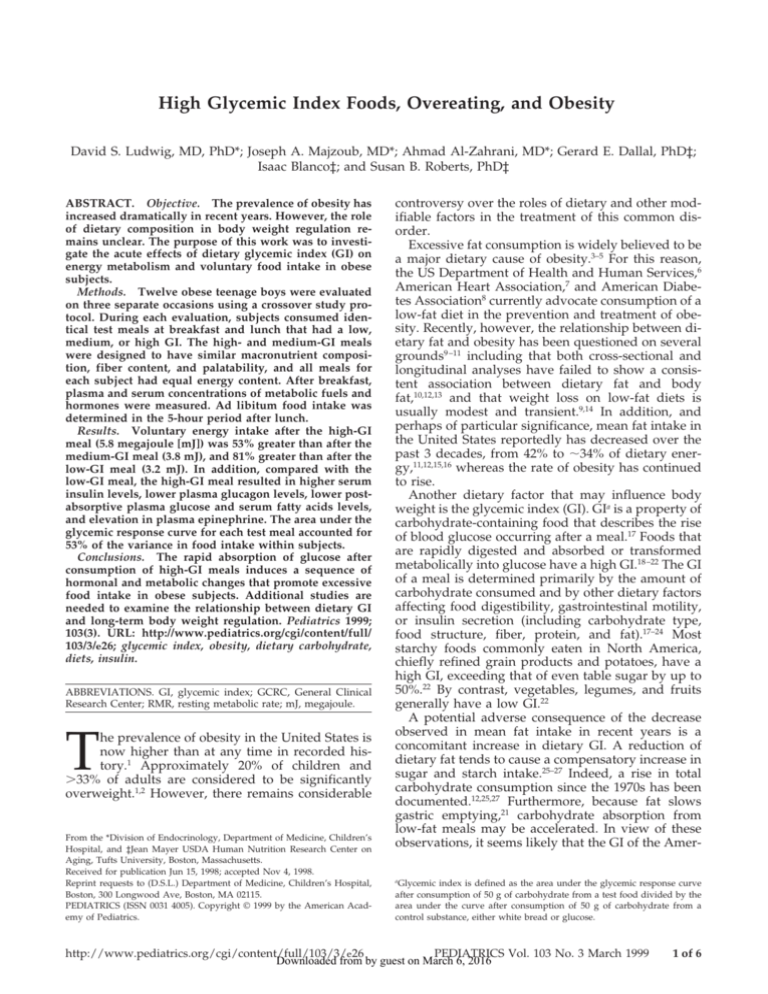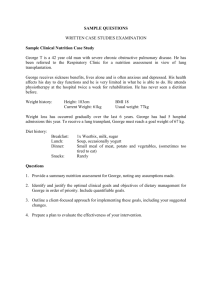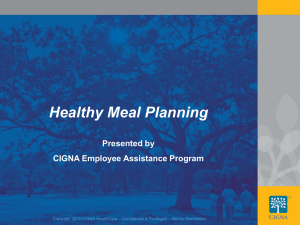
High Glycemic Index Foods, Overeating, and Obesity
David S. Ludwig, MD, PhD*; Joseph A. Majzoub, MD*; Ahmad Al-Zahrani, MD*; Gerard E. Dallal, PhD‡;
Isaac Blanco‡; and Susan B. Roberts, PhD‡
ABSTRACT. Objective. The prevalence of obesity has
increased dramatically in recent years. However, the role
of dietary composition in body weight regulation remains unclear. The purpose of this work was to investigate the acute effects of dietary glycemic index (GI) on
energy metabolism and voluntary food intake in obese
subjects.
Methods. Twelve obese teenage boys were evaluated
on three separate occasions using a crossover study protocol. During each evaluation, subjects consumed identical test meals at breakfast and lunch that had a low,
medium, or high GI. The high- and medium-GI meals
were designed to have similar macronutrient composition, fiber content, and palatability, and all meals for
each subject had equal energy content. After breakfast,
plasma and serum concentrations of metabolic fuels and
hormones were measured. Ad libitum food intake was
determined in the 5-hour period after lunch.
Results. Voluntary energy intake after the high-GI
meal (5.8 megajoule [mJ]) was 53% greater than after the
medium-GI meal (3.8 mJ), and 81% greater than after the
low-GI meal (3.2 mJ). In addition, compared with the
low-GI meal, the high-GI meal resulted in higher serum
insulin levels, lower plasma glucagon levels, lower postabsorptive plasma glucose and serum fatty acids levels,
and elevation in plasma epinephrine. The area under the
glycemic response curve for each test meal accounted for
53% of the variance in food intake within subjects.
Conclusions. The rapid absorption of glucose after
consumption of high-GI meals induces a sequence of
hormonal and metabolic changes that promote excessive
food intake in obese subjects. Additional studies are
needed to examine the relationship between dietary GI
and long-term body weight regulation. Pediatrics 1999;
103(3). URL: http://www.pediatrics.org/cgi/content/full/
103/3/e26; glycemic index, obesity, dietary carbohydrate,
diets, insulin.
ABBREVIATIONS. GI, glycemic index; GCRC, General Clinical
Research Center; RMR, resting metabolic rate; mJ, megajoule.
T
he prevalence of obesity in the United States is
now higher than at any time in recorded history.1 Approximately 20% of children and
.33% of adults are considered to be significantly
overweight.1,2 However, there remains considerable
From the *Division of Endocrinology, Department of Medicine, Children’s
Hospital, and ‡Jean Mayer USDA Human Nutrition Research Center on
Aging, Tufts University, Boston, Massachusetts.
Received for publication Jun 15, 1998; accepted Nov 4, 1998.
Reprint requests to (D.S.L.) Department of Medicine, Children’s Hospital,
Boston, 300 Longwood Ave, Boston, MA 02115.
PEDIATRICS (ISSN 0031 4005). Copyright © 1999 by the American Academy of Pediatrics.
controversy over the roles of dietary and other modifiable factors in the treatment of this common disorder.
Excessive fat consumption is widely believed to be
a major dietary cause of obesity.3–5 For this reason,
the US Department of Health and Human Services,6
American Heart Association,7 and American Diabetes Association8 currently advocate consumption of a
low-fat diet in the prevention and treatment of obesity. Recently, however, the relationship between dietary fat and obesity has been questioned on several
grounds9 –11 including that both cross-sectional and
longitudinal analyses have failed to show a consistent association between dietary fat and body
fat,10,12,13 and that weight loss on low-fat diets is
usually modest and transient.9,14 In addition, and
perhaps of particular significance, mean fat intake in
the United States reportedly has decreased over the
past 3 decades, from 42% to ;34% of dietary energy,11,12,15,16 whereas the rate of obesity has continued
to rise.
Another dietary factor that may influence body
weight is the glycemic index (GI). GIa is a property of
carbohydrate-containing food that describes the rise
of blood glucose occurring after a meal.17 Foods that
are rapidly digested and absorbed or transformed
metabolically into glucose have a high GI.18 –22 The GI
of a meal is determined primarily by the amount of
carbohydrate consumed and by other dietary factors
affecting food digestibility, gastrointestinal motility,
or insulin secretion (including carbohydrate type,
food structure, fiber, protein, and fat).17–24 Most
starchy foods commonly eaten in North America,
chiefly refined grain products and potatoes, have a
high GI, exceeding that of even table sugar by up to
50%.22 By contrast, vegetables, legumes, and fruits
generally have a low GI.22
A potential adverse consequence of the decrease
observed in mean fat intake in recent years is a
concomitant increase in dietary GI. A reduction of
dietary fat tends to cause a compensatory increase in
sugar and starch intake.25–27 Indeed, a rise in total
carbohydrate consumption since the 1970s has been
documented.12,25,27 Furthermore, because fat slows
gastric emptying,21 carbohydrate absorption from
low-fat meals may be accelerated. In view of these
observations, it seems likely that the GI of the Amera
Glycemic index is defined as the area under the glycemic response curve
after consumption of 50 g of carbohydrate from a test food divided by the
area under the curve after consumption of 50 g of carbohydrate from a
control substance, either white bread or glucose.
http://www.pediatrics.org/cgi/content/full/103/3/e26
PEDIATRICS Vol. 103 No. 3 March 1999
Downloaded from by guest on March 6, 2016
1 of 6
ican diet has risen in recent years. Previously, an
inverse relationship between GI and satiety has been
shown in several,28 –32 but not all,33 single-meal studies. Although these reports suggest a potential influence of GI on short-term energy intake, the practical
relevance of GI to energy regulation and obesity
remains unclear.
The purpose of this investigation was to test the
hypothesis that consumption of high-GI foods induces a sequence of hormonal changes that lead to
decreased availability of metabolic fuels, excessive
hunger, and overeating in obese subjects.
METHODS
Subjects
The subjects were pubertal boys (mean age, 15.7 6 1.4 [standard deviation] years) .120% of ideal body weight (mean, 190 6
30.8%) by comparison with national standards.34 Mean values for
weight and height were 106.6 6 22.3 kg and 1.68 6 0.09 m,
respectively. All subjects were healthy, as assessed by physical
examination and laboratory analysis (complete blood count, electrolytes, liver function tests, glycosylated hemoglobin, thyroid
stimulating hormone and urinalysis). Twelve subjects successfully
completed the protocol; one additional individual agreed to participate but was removed from the study because of recurrent
difficulties establishing and maintaining intravenous access. The
research was conducted at the General Clinical Research Center
(GCRC), Children’s Hospital, Boston, MA, with approval from the
investigational review board and written informed consent from
the subjects and parents of minors.
Protocol
A crossover study was conducted, consisting of three separate
24-hour admissions separated by a 1- to 2-week wash-out period.
A different test meal (low-, medium-, or high- GI) was given at
each admission; otherwise, the admissions were conducted in an
identical manner. Subjects were randomly assigned to receive
low-GI or high-GI test meals during the first two admissions,
followed by medium-GI test meals during the third admission.
Subjects were admitted to the GCRC at 6:00 pm, consumed a
low-GI dinner and bedtime snack, and then went to bed at 10:00
pm. The next morning, subjects were awakened at 6:45 am, and an
intravenous line placed, baseline blood samples obtained, and a
10-cm analog hunger scale rating (anchored with statements “not
at all hungry” and “extremely hungry”) completed. A low-, medium-, or high-GI test meal was given for breakfast and consumed
completely in 20 minutes. Blood samples were obtained and hunger scale ratings performed every 30 minutes for 5 hours from the
start of breakfast. After 5 hours, the intravenous line was removed. A second test meal (identical to the breakfast on that day)
then was given for lunch and consumed completely in 20 minutes.
After lunch, subjects were allowed out of bed to perform quiet
activities and were encouraged to ask for an ad libitum meal
platter if and when they were “very hungry” at any time during
the subsequent 5-hour period. They were told to eat as much or as
TABLE 1.
little as they wanted from this platter to feel satisfied and to
request additional fresh platters if they became “very hungry”
again later in the afternoon. Subjects were discharged 5 hours after
lunch and instructed to follow their usual diet until the next
admission.
Diets
All meals were prepared under supervision of the research
dietitians at Brigham and Women’s Hospital, Boston, MA. Nutrient compositions were determined using the software Food Processor Plus, Version 6.0, 1994 (ESHA Research, Salem, OR).
The standard low-GI dinner given on the evening of each
admission consisted of chicken, broccoli, salad with dressing, fruit
and cookies (40% energy from carbohydrate, 30% from protein,
30% from fat; total energy content 18.5% of predicted resting
metabolic rate (RMR) calculated from body weight at preadmission physical examination35). The bedtime snack consisted of fruit
and cheese (energy content 5% of predicted RMR35) and had the
same macronutrient breakdown as the dinner.
Three different test meals with low, medium, and high GI were
studied (Table 1). The high- and medium-GI meals contained
identical foods and nutrients with the exception of the type of
oatmeal (“instant oatmeal” was used for the high-GI meal and
“steel cut” oats for the medium-GI meal, both cooked for 15
minutes) and the type of sweetener (glucose plus artificial sweetener for the high-GI meal and fructose for the medium-GI meal).
Also, milk used in the high-GI meal was treated with 2 drops of
lactase (Dairy Ease Lactaid Drops, Rite Aid Corp, Harrisburg, PA)
to increase the GI of the milk sugar. The instant oatmeal was
produced from whole-grain, dehulled oats according to standard
methods20 (Vargarda Kvarn AB, Vargarda, Sweden). Steel-cut
oats, a preparatory method that preserves the structure of the oat
kernel, thereby lowering GI, also was produced from whole-grain,
de-hulled oats (Heartland Mill Inc, Scott City, KS). The instant oats
had a slightly lower water content than the steel-cut oats, as
determined by bomb calorimetry (1.024 vs 4.971 kilojoule/g, respectively), and the amount of oats used for the two meals were
adjusted accordingly to ensure equivalent energy. In addition to
the two oatmeal test meals, a third, low-GI test meal was used.
This meal (a vegetable omelet and fruit) contained more protein
and fat and less carbohydrate than did the high-GI meal and was
designed to increase the range of GI in the study beyond that
which could be achieved by manipulating only food structure and
carbohydrate type (as with the high- and medium-GI meals). The
size of the test meals was determined individually for each subject
as 18.5% of predicted RMR.35 Although values for predicted RMR
were not expected to be accurate for each subject, they provided a
means to standardize meal size among individuals of different
body weight.
The ad libitum meal food platters used for measurement of
voluntary energy intake after the lunch test meals contained ;22.6
mJ each and included bread, bagels, cold cuts, cream cheese,
regular cheese, spreads, cookies, fruit, and water. Two platters
containing preweighed items were prepared for each subject. The
first platter was given to the subject after the first request for food
during the afternoon of the test day, and the second platter was
given if a second request was made. No subject requested food
more than twice during any of the afternoon measurements. Left-
Meal Composition Based on Sample Test Meals Containing 1.65 mJ
Foods
% Energy from carbohydrate
% Energy from protein
% Energy from fat
Energy density (kJ/g)
Low GI
Medium GI
High GI
55 g Whole egg
45 g Egg white
40 g Low-fat cheese
200 g Spinach
30 g Tomato
185 g Grapefruit
115 g Apple slices
40
30
30
2.46
63.9 g Steel-cut oats*
160 g 2% Milk
15 g Half & Half cream
16.0 g Fructose
0.0 g Saccharine
397 g Water
60.9 g Instant oatmeal*
160 g 2% Milk**
15 g Half & Half cream
19.0 g Dextrose
0.2 g Saccharine
397 g Water
64
16
20
2.52
64
16
20
2.52
Figures represent precooked weights. * Weight of oats used were adjusted to reflect differences in hydration, as described in “Methods.”
** Treated with lactase to increase the GI of milk sugar.
2 of 6
HIGH GLYCEMIC INDEX FOODS, OVEREATING, AND OBESITY
Downloaded from by guest on March 6, 2016
over foods on each platter were weighed to determine the amount
of energy consumed at each meal request.
Blood Analysis
Blood samples were analyzed with the following instruments
or kits: plasma glucose, APEC Glucose Analyzer (APEC, Inc,
Peabody, MA); serum insulin, Abbott IMx (Abbott Laboratories,
Abbott Park, IL); serum fatty acids, Hitachi 917 Analyzer (Wako
Chemicals USA, Inc, Richmond, VA); and serum growth hormone,
IRMA kit (Quest Diagnostics Incorporated, San Juan Capistrano,
CA). Plasma glucagon36 and epinephrine37 were determined at
Quest Diagnostics Incorporated by modifications of standard
methods.
Data Analysis
Responses were evaluated by using repeated-measures analysis
of variance with meal alone or meal and time as within-subjects
factors, as appropriate. Tukey’s honestly significant differences
was used to adjust for multiple meal comparisons except in the
cases of fatty acids, epinephrine, and growth hormone, for which
only the high- and low-GI meals were compared. Within-subject
correlation coefficients between afternoon energy intake and hormonal and metabolic parameters were calculated by using the
method of Bland and Altman.38 The effect of the order in which
meals were taken was investigated by fitting a set of models that
included a term denoting the order in which a meal was eaten. No
order effect reached statistical significance, and the order effects
were not included in subsequent analyses. Areas under the glycemic and insulin response curves were calculated using the trapezoidal rule for values above baseline. All calculations were performed by using SYSTAT for Windows, version 7 (SPSS, Inc,
Chicago, IL).
RESULTS
Hormonal and metabolic responses to the three
test meals given at breakfasts are shown in Fig 1. The
mean area under the glycemic response curve for the
high-GI meal (284 mmoles-min/L) was twice that of
the medium-GI meal (141 mmoles-min/L; P , .001)
and nearly fourfold that of the low-GI meal (76.6
mmoles-min/L; P , .001). The mean plasma glucose
concentration nadir was lower after the high-GI meal
(1.1 mmole/L below baseline) than after the medium-GI meal (0.64 mmole/L below baseline; P 5 .02)
or the low-GI meal (0.64 mmole/L below baseline;
P 5 .02). Insulin level, as assessed by area under the
insulin response curve, was greater after the high-GI
meal (135 nmoles-min/L) than after the medium-GI
meal (88.5 nmoles-min/L; P , .01) or low-GI meal
(62.7 nmoles-min/L; P , .01). Plasma glucagon level
rose after the low-GI meal but was suppressed after
the medium- and high-GI meals, as measured by
area under the curve from 0.5 hour to 4.5 hours (low
GI vs medium or high GI; P , .01). Serum fatty acids,
averaged over the period from 2.5 to 4.5 hours, were
suppressed to a greater degree after the high-GI meal
compared with the low-GI meal (P , .05). Higher
concentrations of the counterregulatory hormones
epinephrine (P , .05) and growth hormone (P 5 .07)
Fig 1. Hormonal and metabolic changes after test
breakfasts. Plot symbols: square, high-GI meal; circle,
medium-GI meal; triangle, low-GI meal.
http://www.pediatrics.org/cgi/content/full/103/3/e26
Downloaded from by guest on March 6, 2016
3 of 6
occurred at 4.5 and 5.0 hours after the high-GI meal
relative to the low-GI meal.
Furthermore, morning ratings of hunger were
greater at all time points after the high-GI breakfast
compared with the low-GI breakfast, with the
medium-GI breakfast yielding intermediate scores
(Fig 2).
After completion of the morning study measurements, a second test meal was given at lunch (identical in composition and amount to the breakfast
meal for that day), and the amount and timing of
voluntary food requests were recorded for a subsequent period of 5 hours. Subjects consumed significantly more energy after the high-GI meal (5.8 mJ)
than after the medium-GI meal (3.8 mJ; P , .05) or
the low-GI meal (3.2 mJ; P 5 .01), as shown in Fig 3.
In addition, mean time to the first meal request after
lunch (2.6, 3.2, and 3.9 hours for the high-, medium-,
and low-GI meals, respectively) differed between
test meal groups (high GI vs low GI; P 5 .01; high GI
vs medium GI, not significant).
Multiple regression analysis (Table 2) showed that
the area under the glycemic response curve was the
strongest predictor of voluntary food intake, accounting for 53% of the intrasubject variance (P ,
.001). In models using pairs of hormonal and metabolic parameters for all three dietary treatments combined, the area under the glycemic response curve
was consistently the only statistically significant independent predictor of within-subject variability in
voluntary energy intake.
DISCUSSION
On average, our obese subjects ate 81% more total
energy after consuming two meals of instant oatmeal
than they did after consuming two meals with the
same amount of energy in the form of a vegetable
omelet and fruit. In addition, they ate 53% more
energy after the high-GI instant oatmeal than they
did after the medium-GI steel-cut oatmeal. These
results demonstrate that commonly consumed meals
containing identical amounts of energy may have
markedly different effects on metabolism, perceived
hunger, and subsequent food intake. Indeed, rela-
Fig 2. Change in hunger after test breakfasts. Hunger is determined by a 10-cm analog scale.
4 of 6
Fig 3. Cumulative food intake after test lunches. Food intake is
quantitated as total energy consumed, expressed in megajoules,
and normalized to a predicted RMR of 8.4 mJ (2000 kcal).
tively unfavorable responses were observed after the
high-GI meal, a low-fat, whole-grain meal consistent
with current nutritional recommendations.6 – 8
To maximize differences in GI, the low-GI vegetable omelet with fruit contained more protein, more
fat, and less carbohydrate than did the high-GI instant oatmeal. However, the observed differences in
subsequent voluntary energy intake can be primarily
attributed to differences in the GI itself, because similar differences, although of slightly lesser magnitude, were obtained when comparing the energy
intake after the high-GI instant oatmeal versus the
medium-GI steel-cut oatmeal. For these two oatmeal
preparations, macronutrient compositions were
identical and alterations in GI were obtained through
differences in food structures and sugar type.
The importance of GI was demonstrated further in
multiple regression analyses of relationships between voluntary energy intake after the test meals
and hormonal and metabolic responses to the meals.
Fully 53% of within-subject variability in voluntary
energy intake after the three different test meals was
accounted for by differences in area under the glycemic response curve. Moreover, in models using
pairs of hormonal and metabolic parameters, area
under the glycemic response curve emerged as the
only significant independent predictor of energy intake.
Concerning the underlying reason for why
high-GI meals may influence hunger and voluntary
energy intake, the hormonal and metabolic responses to the high-, medium-, and low-GI meals
were markedly different. Serum insulin concentrations were high after the high-GI meal because of the
rapid absorption of glucose. By contrast, plasma glucagon levels were suppressed, most likely because of
the low protein content of the meal and the inhibitory effects of high plasma glucose and insulin concentrations.39 This combination of relative hyperinsulinemia and hypoglucagonemia would tend to
promote glucose uptake in muscle and liver, restrain
hepatic glucose production, and suppress lipolysis.
As a consequence, circulating concentrations of glucose and fatty acids were decreased after the absorption of the high-GI meal, compared with the low-GI
HIGH GLYCEMIC INDEX FOODS, OVEREATING, AND OBESITY
Downloaded from by guest on March 6, 2016
TABLE 2.
Parameters
Within-subject Correlation Coefficients for Associations Between Afternoon Energy Intake and Hormonal and Metabolic
High-, Medium-, and Low-GI Meals Combined
Area under glycemic response curve
Plasma glucose nadir
Serum fatty acids (2.5–4.5 h)
Area under insulin response curve
Peak insulin concentration
R
10.731
20.563
20.600
10.645
10.515
P
,.001
.004
.01
.001
.01
R
10.748
20.692
20.682
10.656
10.460
P
.003
.009
.02
.02
.11
High- and Medium-GI Meals Only (Containing Identical Foods)
Area under glycemic response curve
Blood glucose nadir
Serum fatty acids (2.5–4.5 h)
Area under insulin response curve
Peak insulin concentration
meal. Elevations in counterregulatory hormones provide evidence that the reduction observed in availability of these two major metabolic fuels is of physiologic importance. The increased hunger and food
intake after a high-GI meal thus can be viewed as an
attempt to restore energy homeostasis, as demonstrated, for example, after glucoprivation and related
experiments.40,41 These results suggest a reason why
conventional diets have such poor long-term outcomes42: high-GI hypocaloric diets would tend to
exacerbate hunger, leading eventually to overeating;
by contrast, low-GI diets may lessen hunger and
improve long-term compliance.
These physiologic changes may be understood further by a consideration of glucose pharmacodynamics. The body has a constant minimum requirement
for glucose, in contrast to that of other macronutrients, determined largely by the metabolic demands
of the brain. However, nutrient intake is episodic.
During the absorptive phase after a meal, the rate of
glucose delivery tends to exceed oxidation, and excess glucose is stored as glycogen. The situation is
reversed in the postabsorptive phase, when glucose
is released from the liver. Meals resulting in rapid
glucose influx (ie, high GI) challenge the body’s ability to shift smoothly from absorptive to postabsorptive physiology, in part because of altered insulin
and glucagon secretion. Several studies have suggested metabolic advantages, including possibly decreased adiposity, associated with consumption of
frequent small meals compared with infrequent large
ones.43– 45 Low-GI meals, by slowing the rates of nutrient absorption, may provide similar benefits.
Two methodologic issues should be addressed.
First, for logistic reasons, this study was not performed in a “double-blind” manner and, therefore,
the presence of uncontrolled bias cannot be ruledout. Although this concern cannot be negated completely, it should be noted that standardized procedures were used for each different test and, in
addition, the results reported are consistent with
those from previous studies describing an inverse
relationship between GI and short-term satiety.28 –32
Second, we chose obese subjects, believing that this
group (perhaps for genetic reasons as presented below) would demonstrate the greatest sensitivity to
GI. However, other studies have reported a direct association between GI and appetite in lean subjects.28 –32
Regarding a central issue of interpretation, we recognize that this study evaluated only the acute effects of low-GI meals; the effectiveness of a low-GI
diet in promoting long-term weight loss is unknown.
Indeed, several lines of investigation suggest that
body weight is regulated within a specific range,46 – 48
raising the concern that compensatory, genetically
determined mechanisms may tend to antagonize
weight loss on a low-GI diet over the long term.
However, environmental factors also must play an
important role in body weight regulation, as demonstrated simply by the dramatic increase in mean
body mass index in recent years among genetically
stable populations.1 The present study suggests that
dietary GI may be one of those environmental factors. Long-term dietary intervention studies are necessary to resolve this question.
Additional insight into the relationship between
genetics and environment can be found in a report
by Sigal and colleagues.49 When the results of intravenous glucose tolerance tests were compared prospectively with body weight changes in glucosetolerant offspring of parents with diabetes mellitus,
high acute insulin secretion and insulin sensitivity
were found to correlate with weight gain. Thus, various factors that augment insulin secretion or action
(intrinsic to islet cells, at peripheral sites of action, or
dietary) might promote obesity. Individuals who,
perhaps for genetic reasons, have an exuberant insulin response to glucose may be especially sensitive to
dietary GI.
In summary, this study demonstrates that consumption of high-GI foods induces hormonal and
metabolic changes that limit availability of metabolic
fuels and lead to overeating in obese subjects. Additional research is required to determine the longterm significance of GI to human health and the
optimal composition of a low-GI diet. Nevertheless,
this study suggests possible advantages for treatment of obesity of a diet with abundant quantities of
vegetables, legumes, and fruits; decreased amounts
of high-GI carbohydrates; and moderate intake of
protein and fats. Moreover, reductions in dietary GI
also may have beneficial effects on serum lipids,50
risk of diabetes mellitus,51 and other diseases associated with hyperinsulinemia.52
http://www.pediatrics.org/cgi/content/full/103/3/e26
Downloaded from by guest on March 6, 2016
5 of 6
ACKNOWLEDGMENTS
This work was supported by a Pilot Award from Children’s
Hospital, Boston, MA, and by National Institutes of Health Grants
2 M01 RR 02172, M01 RR 02635, K08 DK 02440, and DK 46 124.
We thank Drs Benjamin Brown, Glenn Rothfeld, Yvonne
Granfeldt, Joseph Wolfsdorf, and Richard Malley for advice and
encouragement. This study would not have been possible without
the support of Dorothy Patton, RN, MS; Catherine Murphy, RN;
and the nurses of the General Clinical Research Center, Children’s
Hospital, Boston, MA). Chris Mosunic provided expert technical
assistance. The research dietitians Rita Tsay, MS, RD (GCRC,
Massachusetts Institute of Technology, Boston, MA); Janis Swain,
MS, RD; Courtney Larsen, RD; and Tracy Girouard, RD (GCRC,
Brigham & Women’s Hospital, Boston, MA) provided invaluable
assistance with all aspects of dietary design and meal preparation.
REFERENCES
1. Kuczmarski RJ, Flegal KM, Campbell SM, Johnson CL. Increasing prevalence of overweight among US adults: the National Health and Nutrition Examination Surveys, 1960 –1991. JAMA. 1994;272:205–211
2. Troiano RP, Flegal KM, Kuczmarski RJ, Campbell SM, Johnson CL.
Overweight prevalence and trends for children and adolescents: the
National Health and Nutrition Examination Surveys, 1963–1991. Arch
Pediatr Adolesc Med. 1995;149:1085–1091
3. Golay A, Bobbioni E. The role of dietary fat in obesity. Int J Obes.
1997;21:S2–S11
4. Astrup A, Raben A. Obesity: an inherited metabolic deficiency in the
control of macronutrient balance? Eur J Clin Nutr. 1992;46:611– 620
5. Rolls BJ, Shide DJ. The influence of dietary fat on food intake and body
weight. Nutr Rev. 1992;50:283–290
6. US Department of Health and Human Services, Public Health Service.
The Surgeon General’s Report on Nutrition and Health. Washington, DC:
DHHS (PHS); 1988
7. American Heart Association. Dietary guidelines for healthy American
adults: a statement for health professionals from the nutrition committee, American Heart Association. Circulation. 1996;94:1795–1800
8. American Diabetes Association. Nutrition recommendations and principles for people with diabetes mellitus. Diabetes Care. 1997;20:S14 –S17
9. Katan MB, Grundy SM, Willett WC. Beyond low-fat diets. N Engl J Med.
1997;337:563–566
10. Larson DE, Hunter GR, Williams MJ, Kekes-Szabo T, Nyikos I, Goran
MI. Dietary fat in relation to body fat and intraabdominal adipose
tissue: a cross-sectional analysis. Am J Clin Nutr. 1996;64:677– 684
11. Allred JB. Too much of a good thing? An overemphasis on eating
low-fat foods may be contributing to the alarming increase in overweight among US adults. J Am Diet Assoc. 1995;95:417– 418
12. Nicklas TA. Dietary studies of children: the Bogalusa Heart Study
experience. J Am Diet Assoc. 1995;95:1127–1133
13. Kant AK, Graubard BI, Schatzkin A, Ballard-Barbash R. Proportion of
energy intake from fat and subsequent weight change in the NHANES
1 epidemiologic follow-up study. Am J Clin Nutr. 1995;61:11–17
14. Lissner L, Heitman BL. Dietary fat and obesity: evidence from epidemiology. Eur J Clin Nutr. 1995;49:79 –90
15. Lenfant C, Ernst N. Daily dietary fat and total food-energy intakes—
Third National Health and Nutrition Examination Survey, Phase 1,
1988 –1991. MMWR. 1994;43:116 –117
16. Stephen AM, Wald NJ. Trends in individual consumption of dietary fat
in the United States, 1920 –1984. Am J Clin Nutr. 1990;52:457– 469
17. Wolever TMS, Jenkins DJA, Jenkins AL, Josse RG. The glycemic index:
methodology and clinical implications. Am J Clin Nutr. 1991;54:846 – 854
18. Jenkins DJA, Ghafari H, Wolever TMS, et al. Relationship between rate
of digestion of foods and post-prandial glycaemia. Diabetologia. 1982;22:
450 – 455
19. Bjorck I, Granfeldt Y, Liljeberg H, Tovar J, Asp N-G. Food properties
affecting the digestion and absorption of carbohydrates. Am J Clin Nutr.
1994;59:699S–705S
20. Granfeldt Y, Hagander B, Bjorck I. Metabolic responses to starch in oat
and wheat products. On the importance of food structure, incomplete
gelatinization or presence of viscous dietary fibre. Eur J Clin Nutr.
1995;49:189 –199
21. Welch IM, Bruce C, Hill SE, Read NW. Duodenal and ileal lipid suppresses postprandial blood glucose and insulin responses in man: possible implications for dietary management of diabetes mellitus. Clin Sci.
1987;72:209 –216
22. Foster-Powell K, Miller JB. International tables of glycemic index. Am J
Clin Nutr. 1995;62:871S– 893S
23. Trout DL, Behall KM, Osilesi O. Prediction of glycemic index for starchy
foods. Am J Clin Nutr. 1993;58:873– 878
6 of 6
24. Estrich D, Ravnik A, Schlierf G, Fukayama G, Kinsell L. Effects of
co-ingestion of fat and protein on carbohydrate-induced hyperglycemia. Diabetes. 1967;16:232–237
25. Stephen AM, Sieber GM, Gerster YA, Morgan DR. Intake of carbohydrate and its components—international comparisons, trends overtime,
and effects of changing to low-fat diets. Am J Clin Nutr. 1995;62:
851S– 867S
26. Nicklas TA, Webber LS, Koschak ML, Berenson GS. Nutrient adequacy
of low fat intakes for children: the Bogalusa Heart Study. Pediatrics.
1992;89:221–228
27. Popkin BM, Haines PS, Patterson RE. Dietary changes in older Americans 1977–1987. Am J Clin Nutr. 1992;55:823– 830
28. Haber GB, Heaton KW, Murphy D, Burroughs LF. Depletion and disruption of dietary fibre: effects on satiety, plasma-glucose, and seruminsulin. Lancet. 1977;2:679 – 682
29. Holt S, Brand J, Soveny C, Hansky J. Relationship of satiety to postprandial glycaemic, insulin and cholecystokinin responses. Appetite.
1992;18:129 –141
30. Van Amelsvoort JM, Weststrate JA. Amylose–amylopectin ratio in a
meal affects postprandial variables in male volunteers. Am J Clin Nutr.
1992;55:712–718
31. Leathwood P, Pollet P. Effects of slow release carbohydrates in the form
of bean flakes on the evolution of hunger and satiety in man. Appetite.
1988;10:1–11
32. Rodin J, Reed D, Jamner L. Metabolic effects of fructose and glucose:
implications for food intake. Am J Clin Nutr. 1988;47:683– 689
33. Holt SHA, Brand Miller JC, Petocz P. Interrelationships among postprandial satiety, glucose and insulin responses and changes in subsequent food intake. Eur J Clin Nutr. 1996;50:788 –797
34. Hamill PV, Drizd TA, Johnson CL, Reed RB, Roche AF, Moore WM.
Physical growth: National Center for Health Statistics percentiles. Am J
Clin Nutr. 1979;32:607– 629
35. National Research Council. Recommended Dietary Allowances. 10th ed.
Washington, DC: National Academy Press; 1989
36. Sperling MA, DeLamater PV, Kazenelson M, Fiser RH, Fisher DA.
Development and application of a radioimmunoassay for plasma glucagon. Clin Chem. 1974;20:566 –570
37. Rosano TG. Liquid-chromatographic evaluation of age-related changes
in the urinary excretion of free catecholamines in pediatric patients. Clin
Chem. 1984;30:301–303
38. Bland JM, Altman DG. Calculating the correlation coefficient with repeated observations. I. Correlation within subjects. Br Med J. 1995;310:446
39. Rorsman P, Ashcroft FM, Berggren P-O. Regulation of glucagon release
from pancreatic A-cells. Biochem Pharmacol. 1991;41:1783–1790
40. Thompson DA, Campbell RG. Hunger in humans induced by 2-deoxyd-glucose: glycoprivic control of taste preference and food intake. Science. 1977;198:1065–1068
41. Campfield LA, Smith FJ, Rosenbaum M, Hirsh J. Human eating: evidence for a physiologic basis using a modified paradigm. Neurosci
Neurobehav Rev. 1996;20:133–137
42. NIH Technology Assessment Conference Panel. Methods for voluntary
weight loss and control. Ann Intern Med. 1993;119:764 –770
43. Jenkins DJA, Wolever TMS, Vuksan V, et al. Nibbling versus gorging:
metabolic advantages of increased meal frequency. N Engl J Med. 1989;
321:929 –934
44. Fabry P, Tepperman J. Meal frequency—a possible factor in human
pathology. Am J Clin Nutr. 1970;23:1059 –1068
45. Hollifield G, Parson W. Metabolic adaptations to a “stuff and starve”
feeding program. II. Obesity and the persistence of adaptive changes in
adipose tissue and liver occurring in rats limited to a short daily feeding
period. J Clin Invest. 1962;41:250 –253
46. Bouchard C. Genetic factors in obesity. Med Clinic N Am. 1989;73:67– 81
47. Rosenbaum M, Leibel RL, Hirsch J. Obesity. N Engl J Med. 1997;337:
396 – 407
48. Stunkard AJ, Harris JR, Pedersen NL, McClearn GE. The body-mass
index of twins who have been reared apart. N Engl J Med. 1990;322:
1483–1487
49. Sigal RJ, El-Hashimy M, Martin BC, Soeldner JS, Krolewski AS, Warram
JH. Acute postchallenge hyperinsulinemia predicts weight gain: a prospective study. Diabetes. 1997;46:1025–1029
50. Jenkins DJA, Wolever TMS, Kalmusky J, et al. Low-glycemic index diet
in hyperlipidemia: use of traditional starchy foods. Am J Clin Nutr.
1987;46:66 –71
51. Salmeron J, Manson JE, Stampfer MJ, Colditz GA, Wing AL, Willett WC.
Dietary fiber, glycemic load, and risk of non-insulin-dependent diabetes
mellitus in women. JAMA. 1997;277:472– 477
52. Reaven GM. Banting lecture 1988: role of insulin resistance in human
disease. Diabetes. 1988;37:1595–1607
HIGH GLYCEMIC INDEX FOODS, OVEREATING, AND OBESITY
Downloaded from by guest on March 6, 2016
High Glycemic Index Foods, Overeating, and Obesity
David S. Ludwig, Joseph A. Majzoub, Ahmad Al-Zahrani, Gerard E. Dallal, Isaac
Blanco and Susan B. Roberts
Pediatrics 1999;103;e26
DOI: 10.1542/peds.103.3.e26
Updated Information &
Services
including high resolution figures, can be found at:
/content/103/3/e26.full.html
References
This article cites 50 articles, 24 of which can be accessed free
at:
/content/103/3/e26.full.html#ref-list-1
Citations
This article has been cited by 5 HighWire-hosted articles:
/content/103/3/e26.full.html#related-urls
Subspecialty Collections
This article, along with others on similar topics, appears in the
following collection(s):
Nutrition
/cgi/collection/nutrition_sub
Obesity
/cgi/collection/obesity_new_sub
Permissions & Licensing
Information about reproducing this article in parts (figures,
tables) or in its entirety can be found online at:
/site/misc/Permissions.xhtml
Reprints
Information about ordering reprints can be found online:
/site/misc/reprints.xhtml
PEDIATRICS is the official journal of the American Academy of Pediatrics. A monthly
publication, it has been published continuously since 1948. PEDIATRICS is owned, published, and
trademarked by the American Academy of Pediatrics, 141 Northwest Point Boulevard, Elk Grove
Village, Illinois, 60007. Copyright © 1999 by the American Academy of Pediatrics. All rights
reserved. Print ISSN: 0031-4005. Online ISSN: 1098-4275.
Downloaded from by guest on March 6, 2016
High Glycemic Index Foods, Overeating, and Obesity
David S. Ludwig, Joseph A. Majzoub, Ahmad Al-Zahrani, Gerard E. Dallal, Isaac
Blanco and Susan B. Roberts
Pediatrics 1999;103;e26
DOI: 10.1542/peds.103.3.e26
The online version of this article, along with updated information and services, is
located on the World Wide Web at:
/content/103/3/e26.full.html
PEDIATRICS is the official journal of the American Academy of Pediatrics. A monthly
publication, it has been published continuously since 1948. PEDIATRICS is owned,
published, and trademarked by the American Academy of Pediatrics, 141 Northwest Point
Boulevard, Elk Grove Village, Illinois, 60007. Copyright © 1999 by the American Academy
of Pediatrics. All rights reserved. Print ISSN: 0031-4005. Online ISSN: 1098-4275.
Downloaded from by guest on March 6, 2016








